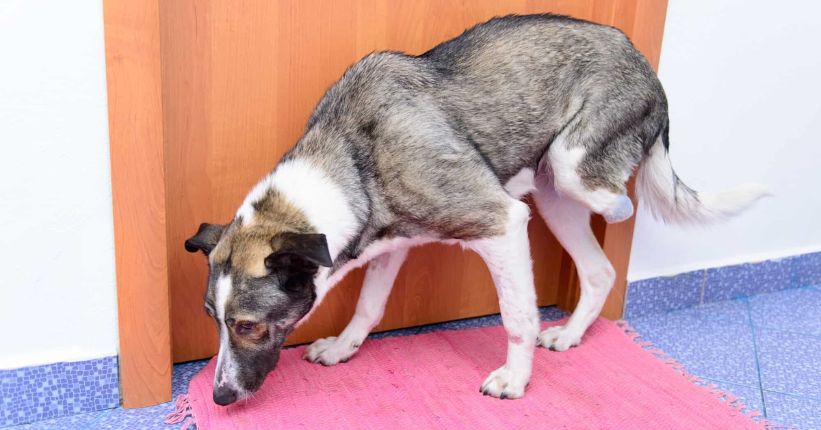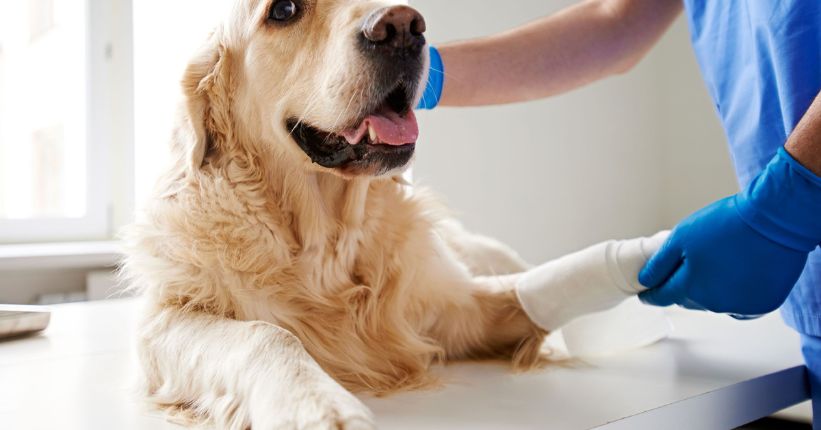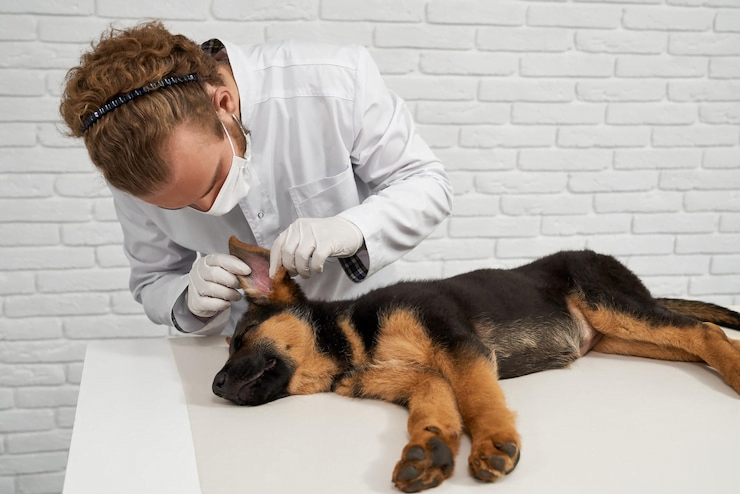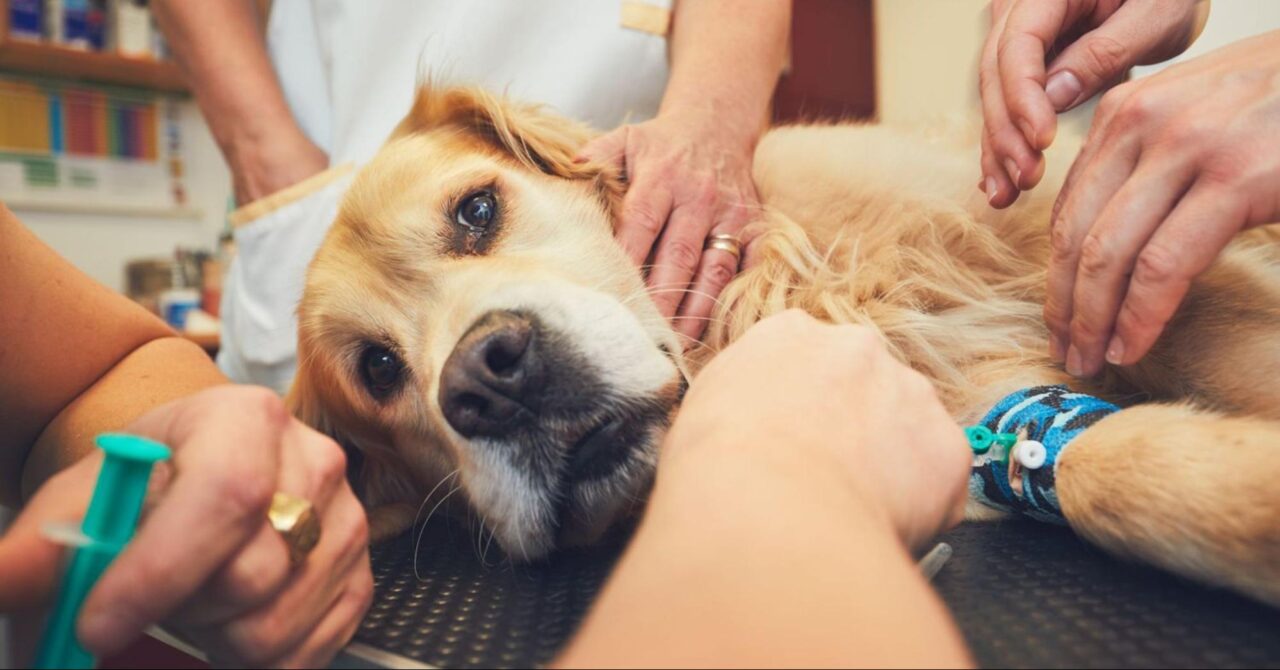When dealing with Dog Cancer Pain Relief, one of the top concerns for pet owners is ensuring that their furry friend is comfortable and pain-free. Identifying and providing effective pain relief for dogs battling cancer is crucial for enhancing their quality of life and supporting their overall well.

The first and most important step in understanding, if your dog needs cancer pain relief, is to closely observe their behavior and look out for any signs of distress. Dogs are masters at hiding pain, so it is essential to be vigilant and attuned to their needs. Some common indicators of cancer pain in dogs include:
- Changes in appetite: A dog experiencing pain may exhibit a loss of appetite or a drastic decrease in food consumption. Be mindful of any changes in their eating habits and consult with your veterinarian.
- Behavioral changes: Dogs in pain may display unusual behaviors such as restlessness, irritability, increased aggression, or withdrawal. Keep an eye out for any sudden shifts in your dog’s demeanor.
- Limping or difficulty in mobility: Cancer can cause pain in the bones, joints, or muscles, leading to limping or difficulty in moving around. If your dog struggles while walking, climbing stairs, or jumping, it could indicate the need for pain relief.
Dog Cancer Pain Relief
When it comes to providing Dog Cancer Pain Relief for dogs with cancer, it is important to consult with your veterinarian. They will be able to provide you with the best options for managing your dog’s pain and ensuring their comfort. There are several treatment options that your veterinarian may recommend for managing your dog’s cancer pain. These may include:
- Medications: Nonsteroidal anti-inflammatory drugs (NSAIDs) can help reduce inflammation and provide pain relief. Your veterinarian may prescribe specific NSAIDs that are safe for dogs and monitor their usage closely. Opioids may also be prescribed for severe pain, but these are used with caution due to their potential side effects.
- Palliative care: Palliative care focuses on improving the quality of life for dogs with cancer by providing symptom relief. This may involve using medications, such as steroids or muscle relaxants, to alleviate pain and discomfort. Other palliative care measures may include physical therapy, acupuncture, or massage to help manage pain and improve mobility.
- Nutritional support: Cancer can result in weight loss and muscle wasting in dogs. Providing a balanced and nutritious diet can help support their overall well-being and improve their strength and resilience to pain. Your veterinarian may recommend specific dietary modifications or supplements to ensure your dog receives the necessary nutrients.
- Complementary therapies: In addition to conventional treatments, some pet owners choose to explore complementary therapies for cancer pain relief. These may include herbal supplements, CBD oil, or acupuncture. While there is limited scientific evidence to support the efficacy of these alternative treatments, some pet owners have reported positive results. However, it’s crucial to discuss these options with your veterinarian before incorporating them into your dog’s treatment plan.
What Can You Give Dogs for Cancer Pain?
When it comes to managing cancer pain in dogs, there are several options available. Your veterinarian will determine the best treatment plan for your dog based on various factors such as the type and stage of cancer, Dog Cancer Pain Relief, your dog’s overall health, and their thresholds. Here are some common pain relief options:
1. Nonsteroidal Anti-Inflammatory Drugs (NSAIDs)
NSAIDs are commonly used in veterinary medicine to reduce inflammation and alleviate pain. They work by inhibiting the production of certain enzymes involved in the inflammatory process. Examples of NSAIDs commonly prescribed for dogs include carprofen, meloxicam, and deracoxib. It is important to use NSAIDs specifically formulated for dogs, as human NSAIDs like ibuprofen and aspirin can be toxic to them.
2. Opioids
In cases where the pain is severe or not adequately managed by NSAIDs, opioids may be prescribed. Opioids are potent pain relievers that work by binding to opioid receptors in the body, reducing the perception of pain. Commonly prescribed opioids for dogs include tramadol, buprenorphine, and fentanyl. It’s important to use opioids under close veterinary supervision, as they can cause side effects and potentially lead to dependence.
3. Palliative care
Palliative care focuses on providing relief from pain and improving the overall quality of life for dogs with cancer. This may involve a combination of medications, behavioral interventions, and supportive care. Your veterinarian may prescribe medications such as gabapentin or amantadine, which can help manage neuropathic pain in dogs. In addition, they may recommend physical therapy, massage, or cold laser therapy to alleviate pain and improve mobility.
How Can I Make my Dog More Comfortable with Cancer?
Cancer can be a challenging experience for both dogs and their owners. However, there are several steps you can take to make your dog more comfortable during their battle with cancer:
- Provide a comfortable environment: Create a cozy and quiet space for your dog where they can rest and feel secure. Make sure the area is free from loud noises, drafts, and excessive temperature changes.
- Monitor their diet: Cancer can affect a dog’s appetite and digestion. Consult with your veterinarian to determine the best diet for your dog’s specific condition. They may recommend a high-quality, balanced diet that supports their overall health and immune system.
- Manage pain and discomfort: Follow your veterinarian’s instructions and administer pain medications as prescribed. Monitor your dog closely for any signs of pain or discomfort, such as changes in behavior or difficulty in mobility. Adjust their pain medication dosage if necessary.
- Offer emotional support: Dogs can sense their owner’s emotions, so try to maintain a calm and positive demeanor around them. Spend quality time with your dog, giving them attention, affection, and reassurance. Engage in activities that they enjoy, such as gentle play or going for easy walks.
- Maintain good hygiene: Keep your dog clean and comfortable by regularly disturbing the dog. This can help them relax and alleviate any stress or anxiety they may be experiencing due to their cancer diagnosis. Consider providing them with a warm and soft bed or blanket to make their resting area even more comfortable.
What is a Comfort Dog for Cancer Patients?
A comfort dog, also known as a therapy dog, is a specially trained canine that provides emotional support, companionship, and comfort to cancer patients. These dogs are often used in healthcare settings, including hospitals, clinics, and cancer treatment centers, to help reduce anxiety, improve mood, and promote relaxation.
Comfort dogs are trained to be calm, gentle, and friendly, with the ability to interact well with people of all ages. They have an instinct to provide and can sense and respond to the emotional needs of cancer patients. Their presence can be uplifting and provide a distraction from the stress and pain associated with cancer treatment.
In addition to offering emotional support, comfort dogs can also provide physical benefits to cancer patients. Studies have shown that spending time with dogs can lower blood pressure, reduce stress hormones, and increase the production of endorphins, which are natural pain relievers. This can help alleviate some of the physical discomfort and pain experienced by cancer patients.
Comfort dogs can be particularly beneficial for children and teenagers undergoing cancer treatment. They can help create a positive and comforting environment, easing their fears and making the treatment process more bearable. These dogs can also provide a sense of normalcy and routine, which can be especially important for young cancer patients who may be facing disruptions in their daily lives.
What to Do When Your Dog Has Terminal Cancer?
Finding out that your dog has terminal cancer can be devastating. While there may not be a cure, there are still steps you can take to provide comfort and pain relief during this difficult time. Here are a few things you can do when your dog has terminal cancer:
- Consult with your veterinarian: It is important to communicate openly with your veterinarian about your dog’s condition and discuss the available treatment options. They can guide you on the best course of action to keep your dog as comfortable as possible.
- Manage pain with medication: Your veterinarian may prescribe pain medication to help manage your dog’s pain. This could include nonsteroidal anti-inflammatory drugs (NSAIDs), opioids, or other pain relievers. It is important to follow your vet’s instructions carefully and monitor your dog for any side effects or changes in behavior.
- Provide a comfortable environment: Create a peaceful and comfortable environment for your dog to rest. Make sure they have a cozy bed or mat in a quiet area of your home. Consider using blankets or cushions to provide additional comfort.
- Adjust their diet: Consult with your veterinarian about your dog’s dietary needs. They may recommend a special diet that is easy to digest and meets your dog’s nutritional requirements. Maintaining your dog’s comfort is crucial during their battle with terminal cancer. To manage their pain, your veterinarian may prescribe pain medication. These medications can include nonsteroidal anti-inflammatory drugs (NSAIDs), opioids, or other pain relievers.
How to Tell if a Dog is in Pain From Cancer?
Dogs, like humans, can experience pain from cancer. However, unlike humans who can communicate their pain, dogs rely on us to recognize the signs and symptoms. It’s important to be attentive and observant of your dog’s behavior to ensure they are not suffering unnecessarily. Here are some common indicators that your dog may be experiencing pain from cancer:
- Changes in appetite: A decrease in appetite or difficulty eating can indicate pain in dogs with cancer. They may show a lack of interest in food or have trouble chewing and swallowing.
- Changes in mobility: Dogs in pain may have difficulty moving or have a noticeable decrease in their mobility. They may display stiffness or limping, or struggle to get up or lie down. If you notice that your dog is having trouble navigating stairs or jumping onto furniture, it could be a sign of pain.
- Behavioral changes: Dogs in pain may exhibit changes in their behavior. They may become more irritable, aggressive, or withdrawn. You may notice that your normally friendly and sociable dog now avoiding interactions or snapping at people or other animals. On the other hand, they may seek more attention and reassurance from you.
- Changes in sleep patterns: Dogs in pain may have difficulty sleeping or may sleep more than usual. They may have trouble finding a comfortable position to sleep in or may wake up frequently throughout the night. Pay attention to any restlessness or signs of discomfort during their sleep.
- Vocalization: Dogs in pain may vocalize more than usual. They may whimper, whine, or yelp when touched or when moving. Excessive panting can also be a sign of pain and discomfort. If your dog is exhibiting these vocalizations without any apparent reason, it’s important to investigate further.
- Changes in grooming habits: Dogs in pain may have difficulty maintaining their grooming routine. They may stop grooming themselves altogether or may only groom certain areas of their body while neglecting others. This can lead to a disheveled or unkempt appearance. Additionally, dogs with cancer may experience skin irritations or lesions, which can cause them to avoid grooming due to discomfort.
How Can I Tell if My Dog is in Pain?
If you suspect your dog may be experiencing pain from cancer, it’s important to consult with your veterinarian for a proper diagnosis. They will be able to assess your dog’s symptoms, conduct a thorough examination, and provide an appropriate treatment plan.
In addition to the common indicators mentioned earlier, there are other signs you can look out for to determine if your dog is in pain. These include:
Licking or biting at a particular area: Dogs may show signs of pain by constantly licking or biting at a specific area of their body. This can indicate that there is discomfort or inflammation in that area.
- Changes in posture: Dogs in pain may exhibit changes in their posture. They may hunch their back, tuck their tail, or have a tense or rigid body. Pay attention to any abnormal body positions or stiffness.
- Changes in breathing: Pain can affect a dog’s breathing pattern. They may breathe more rapidly or shallowly, or they may have irregular breathing. Monitor your dog’s breathing to see if there are any noticeable changes.
- Weight loss: Chronic pain can lead to a loss of appetite, which may result in weight loss. If you notice that your dog is losing weight despite having a normal or increased appetite, it could be that your dog is experiencing pain. Dogs in pain may focus their attention on a specific area by constantly licking or biting at it. This behavior can be a sign of discomfort or inflammation in that area.
How is Pain Treated in Dogs?
When it comes to treating pain in dogs with cancer, there are several options available. The treatment plan will depend on the specific circumstances and needs of the individual dog. Here are some common approaches to managing pain in dogs with cancer:
1. Medications
The most common form of pain relief for dogs with cancer is medication. Nonsteroidal anti-inflammatory drugs (NSAIDs) are often prescribed to reduce inflammation and provide pain relief. These medications can help alleviate discomfort and improve your dog’s quality of life. However, it’s crucial to work closely with your veterinarian to determine the right dosage and monitor for any potential side effects.
2. Opioids
In more severe cases, opioids may be used to manage pain in dogs with cancer. These medications are potent pain relievers and can help control moderate to severe pain. However, opioids should only be used under the guidance of a veterinarian, as they can have side effects and may require careful monitoring.
3. Physical therapy
Physical therapy can play a crucial role in managing pain in dogs with cancer. Techniques such as massage, hydrotherapy, and therapeutic exercises can help relieve pain, improve mobility, and enhance overall well-being. Physical therapy can also help prevent muscle wasting and maintain muscle strength, which
4. Acupuncture
Acupuncture is a form of alternative medicine that involves inserting thin needles into specific points of the body. This practice has been found to help relieve pain in dogs with cancer. Acupuncture stimulates the release of endorphins, which are natural painkillers, and also helps improve blood circulation and reduce inflammation. Many veterinarians now offer acupuncture as part of their treatment options for dogs with cancer.
5. Medications
Non-steroidal anti-inflammatory Drugs (NSAIDs): These drugs help alleviate pain and reduce inflammation. However, it is important to use them under the guidance of a veterinarian, as long-term use can have effects.
Opioids: These are strong pain relievers that are often prescribed for severe pain. They can provide significant relief but may be associated with sedation or constipation.
Steroids: Steroids can help reduce inflammation and relieve pain in dogs with cancer. However, they may have side effects if used long-term, so their use should be carefully monitored by a veterinarian.
6. Palliative care
Palliative care focuses on providing comfort and improving the quality of life for dogs with cancer. This may include providing soft bedding, ensuring a warm and quiet environment, and offering gentle massages.
7. Nutritional support
Proper nutrition is crucial for dogs with cancer, as it can help improve their overall well-being and alleviate pain. Your veterinarian may recommend a balanced diet that includes supplements to support the immune system and prevent muscle wasting.
Radiation therapy: Radiation therapy uses high-energy rays to target and destroy cancer cells. While its primary goal is to treat the cancer itself, radiation therapy can also help reduce pain and discomfort in dogs with cancer. It can shrink tumors, relieve pressure on surrounding tissues, and alleviate symptoms such as pain and inflammation.
8. Surgery
In some cases, surgical procedures may be performed to remove tumors or alleviate pain-causing conditions. Surgery can help reduce pain by eliminating the source of discomfort and improving the dog’s quality of life. However, it is important to note that not all dogs with cancer are candidates for surgery, and the decision should be made in consultation with a veterinarian.
9. Complementary therapies
In addition to conventional treatments, complementary therapies can provide additional pain relief and holistic support for dogs with cancer. These may include herbal remedies, homeopathy, dietary supplements, and CBD products. It is essential to discuss these options with a veterinarian before incorporating them into a dog’s treatment plan, as they may interact with medications or have varying levels of scientific evidence supporting their effectiveness.
How to Tell if Your Dog is in Pain from Cancer?
Recognizing if your dog is in pain from cancer can be challenging, as dogs are experts at hiding their discomfort. However, there are some signs you can look out for that may indicate your furry friend is experiencing pain:
- Changes in behavior: Keep a close eye on your dog’s behavior. If you notice any unusual or out-of-character behavior such as increased aggression, irritability, or withdrawal, it could be a sign that your dog is in pain.
- Changes in appetite: Pay attention to your dog’s eating habits. If they suddenly have a decreased appetite or are reluctant to eat, it could be a sign of pain. On the other hand, some dogs may exhibit an increase in appetite due to certain types of cancer.
- Lethargy or decreased activity levels: Notice if your dog is less active than usual or seems unusually tired. Cancer can cause fatigue and weakness leading to a decrease in physical activity.
- Changes in posture or movement: Observe if your dog is having difficulty moving or is limping. They may display a hunched posture or have trouble getting up and down stairs. These changes in movement could be indicative of pain.
- Vocalization or whimpering: If your dog is vocalizing more than usual, whining, whimpering, or moaning, it could be a sign of pain. Listen for any abnormal sounds and observe their body language for signs of discomfort.
- Changes in grooming habits: Dogs with cancer may experience discomfort while grooming themselves. Take note if your dog is licking or biting a specific area excessively or avoiding grooming altogether.
- Changes in breathing: Pay attention to your dog’s breathing patterns. If you notice rapid or labored breathing, it could be a sign of pain. Dogs with cancer may experience difficulty breathing due to tumors in the chest or the spread of cancer to the lungs.
- Breathing changes: Pay attention to any changes in your dog’s breathing patterns. Rapid, shallow breathing or panting could be a sign of pain or discomfort.
- Changes in sleep patterns: Keep an eye on your dog’s sleep habits. If they are having difficulty falling asleep, staying asleep, or constantly waking up, it could be a sign that they are experiencing pain from cancer.
- Restlessness or pacing: Dogs in pain may become restless and unable to find a comfortable position. They may constantly pace or have difficulty settling down.
- Changes in facial expressions: Pay attention to your dog’s facial expressions. They may exhibit a tense or strained expression, squinting eyes, or a furrowed brow, indicating pain.
- Swelling or lumps: If you notice any lumps or swelling on your dog’s body, it could be a sign of cancer-related pain. These lumps may be present in the lymph nodes, tumors, or other affected areas.
- Weight loss: Cancer can cause weight loss in dogs. If you notice your dog losing weight despite normal food intake, it could be a sign of pain and the need for effective pain relief strategies.
- Changes in appetite: Dogs with cancer may experience a loss of appetite or a decrease in food consumption. Keep an eye out for any sudden changes in their eating habits, such as refusing to eat, picking at their food, or eating significantly less than usual.
How To Know Your Dog Is In Pain?
Recognizing when your dog is in pain is crucial to providing them with the necessary relief. Here are some additional signs to help you determine if your furry friend is experiencing discomfort:
- Changes in sleep patterns: Keep an eye on your dog’s sleeping habits. If they are having difficulty finding a comfortable position or are frequently waking up during the night, it could be a sign of pain.
- Behavioral changes: Watch out for any unusual behaviors in your dog. They may become irritable, aggressive, or withdrawn. Dogs in pain may also display reluctance to be touched or be more reactive to certain stimuli.
- Restlessness or pacing: If your dog is constantly moving, unable to settle down, or pacing back and forth, it could be a sign of discomfort. Restlessness is often seen in dogs with pain.
- Muscle tension or stiffness: Gently feel your dog’s muscles for any tightness or stiffness. Dogs in pain may have tense muscles, especially in the affected areas. They may also have difficulty getting up or lying down.
- Weight loss or loss of muscle tone: Cancer can cause weight loss in dogs. If you notice a significant drop in your dog’s weight or a loss of muscle mass, it could indicate pain or decreased appetite due to cancer.
- Changes in bathroom habits: Pay attention to any changes in your dog’s bathroom habits. They may have difficulty urinating or defecating, or show signs of straining or pain during these activities. This could be a result of cancer affecting the urinary or gastrointestinal system.
It is important to remember that these signs may not always be exclusive to pain caused by cancer.
Should you Treat your Dog for Cancer?
Deciding to treat your dog for cancer is a personal one that should be made in consultation with your veterinarian. It is important to consider factors such as your dog’s age, overall health, and the type and stage of cancer they have.
In many cases, treatments for cancer in dogs can help alleviate pain and improve their quality of life. There are various treatment options available, including surgery, radiation therapy, chemotherapy, immunotherapy, and palliative care.
surgery may be recommended to remove tumors or alleviate discomfort caused by tumors pressing on surrounding tissues or organs. Radiation therapy can be used to target and shrink tumors, reducing pain and other symptoms. Chemotherapy, which involves the use of anti-cancer drugs, can help slow down the growth of cancer cells and alleviate pain.
Immunotherapy is a newer treatment option that harnesses the power of the immune system to fight cancer. It can help improve your dog’s overall well-being and alleviate pain and discomfort. It’s important to note that not all types of cancer respond well to immunotherapy, so it’s best to consult with your veterinarian to see if it is a suitable option for your dog.
Palliative care focuses on providing relief from pain and other symptoms associated with cancer, rather than trying to cure the disease itself. It aims to improve the overall quality of life for the dog by managing pain, nausea, appetite loss, and other symptoms that may arise during cancer.
Conclusion
Dog cancer pain relief is an important aspect of managing your furry friend’s condition. It is crucial to pay attention to signs of pain and discomfort in your dog and consult with your veterinarian for appropriate treatment options. Remember that cancer treatments should be decided on a case-by-case basis, taking into account your dog’s age, overall health, and the type and stage of cancer they have. Additionally, there are various methods and medications available to help provide pain relief for dogs with cancer. Your veterinarian may prescribe pain medications, such as nonsteroidal anti-inflammatory drugs (NSAIDs), opioids, or corticosteroids, to help alleviate your dog’s pain.
NSAIDs are commonly used to reduce inflammation and provide pain relief in dogs with cancer. They work by blocking certain enzymes that contribute to inflammation and pain. However, it’s important to note that not all NSAIDs are safe for use in dogs, and they should only be used under the guidance of a veterinarian.
Opioids, such as morphine or codeine, can be used for more severe pain management. These medications work by binding to opioid receptors in the central nervous system, blocking pain signals and providing relief. Corticosteroids, such as prednisone, can also be used to help reduce inflammation and alleviate pain associated with cancer.
In addition to medications, there are alternative therapies that may provide relief for dogs with cancer. These can include acupuncture, massage therapy, hydrotherapy, and laser therapy. These therapies can help reduce pain, increase circulation, and promote relaxation in your dog.
FAQ
How can I help my dog with cancer pain?
To help manage your dog’s cancer pain, consult with your veterinarian to develop a comprehensive pain management plan. This may include:
- Medications: NSAIDs, opioids, and adjuvant analgesics (like gabapentin).
- Palliative Care: Radiation therapy or chemotherapy to reduce tumor size and alleviate pain.
- Alternative Therapies: Acupuncture, massage, and physical therapy can be beneficial. It’s crucial to follow your vet’s advice and monitor your dog for any side effects from treatments.
How to make dogs with cancer comfortable?
Making your dog comfortable involves creating a supportive and stress-free environment:
- Comfortable Bedding: Provide a soft, supportive, and accessible bed.
- Diet & Hydration: Ensure they receive a balanced diet suitable for their condition and stay hydrated.
- Gentle Exercise: Light activities can keep them engaged without causing fatigue.
- Quality Time: Spend time with them, engaging in their favorite activities.
- Routine: Maintain consistent routines to reduce stress. Regular vet check-ups will help adjust treatments and manage symptoms effectively.
Do dogs with cancer sleep a lot?
Yes, dogs with cancer often sleep more due to fatigue from the disease and side effects of treatments. Increased sleep or lethargy can result from pain, decreased energy levels, and the body’s efforts to heal. It’s essential to observe their behavior and consult with your veterinarian to manage symptoms proactively.
Is it okay to not treat dog cancer?
Deciding not to treat dog cancer is a deeply personal choice and can depend on various factors, such as the dog’s age, overall health, type and stage of cancer, and quality of life considerations. In some cases, treatment may extend life but might not significantly improve the quality of life. Here are some points to consider:
- Palliative Care: Opting for palliative care focuses on alleviating pain and discomfort rather than treating the disease.
- Quality of Life: Ensuring your dog remains comfortable and happy is crucial.
- Discuss With Your Vet: Always consult your veterinarian to understand all options and make an informed decision. Ultimately, prioritizing your dog’s comfort and well-being can guide you in making the best decision for their care.













